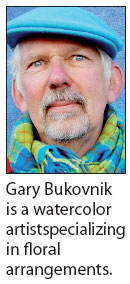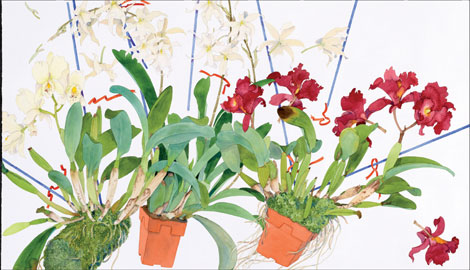Perennial artist
Updated: 2012-01-20 07:35
By Zhang Kun (China Daily)
|
||||||||
|
|
Veteran watercolorist says career and subject matter chose him
Gary Bukovnik says there is just one reason for his being recognized as a modern or contemporary artist: he is still alive.
The watercolorist from San Francisco is showing his artwork at museums throughout China and will take part in the Shanghai Biennale this year.
"Actually my work is kind of conservative, and that was not by design. I am just doing what I naturally like to do. I've tried to do something different, struggling and fighting, but that didn't work out. Then it didn't matter any more. I'll just do what I do."
Bukovnik has worked for 10 months preparing for his exhibition tour in China. He brought 80 pieces on display at the Shanghai Hongqiao Contemporary Art Museum (HCAM) and the Suzhou Academy of Art. This year the pieces will travel to Hangzhou, Xiamen and Beijing.
Similar to traditional Chinese gongbi, or fine stroke paintings, Bukovnik's artworks accurately present - in a larger-than-life scale - the exact botanic structure of flowers. His favorite flower is the tulip, but he has painted lilies, lilacs, roses, peonies, chrysanthemums and many more. His paintings are extremely simple in composition, depicting a bouquet in a vase, pot, or just flowers spread on a clean surface.
"He's different from most of the Chinese artists we've seen," says Zhu Ying, deputy director of HCAM. "He's a pure artist, not thinking about how to impress the audience or get more people to buy his paintings."
Zhu says he was drawn to Bukovnik's artwork becasue of its exuberance, vivacity and the musical rhythm of the flowers.

Bukovnik, born in Cleveland in 1957, spent his childhood in the Ohio countryside. "There were vast fields of flowers - wild daisies, azaleas, and others grown in bushes."
As a boy, Bukovnik always liked to draw, but his mother "wouldn't let me draw anything messy", so he painted in watercolor.
Bukovnik often says he didn't choose his medium or his subject. On the contrary, "they chose me", he says.
Bukovnik's grandparents immigrated to Ohio from Slovenia around the time of World War I. His grandparents ran a small grocery, but when his grandfather died of a medical accident in his early 50s, the landlord drove his grandmother out of the house because, at that time, "only men could sign the lease", Bukovnik says.
His grandmother moved to the countryside, where she opened a similar store. When the work became too much for her, Bukovnik and his parents moved in to help when he was about 3 years old.
Even though Bukovnik showed great interest in art and music, his parents were against the idea of their son becoming an artist.
It was not until 1979, when Bukovnik had a show at the Museum of Pittsburgh Pennsylvania, that his parents recognized his career path. When his father saw the sign for the exhibition with his son's name on it, he was finally impressed and admitted his son chose the right profession.
Even though he found a career as an artist painting flowers, Bukovnik was often frustrated, because flowers and still life were simply too simple. At a time when contemporary artists look for means to impress their audience, to be viewed as deep, sophisticated and academic, he was different and far from the crowd.
"Ever since the 19th century, art has been about looking for yourself and seeing yourself. I, however, didn't have to - I've always had myself." He found his voice in the vivacious flowers that he painted.
He has always painted small ideas and insignificant moments. But by separating them from the mass, he says he gives the insignificant great significance.
A few years ago he was hired as an artist in residence in Rome. He had packed all the necessary art supplies - pens, brushes and all the tools he used for painting - but they never arrived.
After a few days of sightseeing and strolling in the streets, the urge to paint overtook him. He bought a minimal amount of supplies and bouquets of flowers. Since he did not have a vase, he painted the flowers strewn on a table. The composition brought him new inspiration and new incentive to continue painting flowers. Since then, in his paintings, "stems, pots and vases take flight", wrote Stephen Murray, an academic from the United States.
Other inspiration comes from music. Bukovnik once dreamed of being a pianist.
"In Bukovnik's floral subjects, he captures a vibrant yet fleeting beauty that mirrors music itself," the San Francisco Symphony says of Bukovnik's work. The symphony has commissioned a painting each year by Bukovnik since the 1981-82 season.
Another long-term collaboration for Bukovnik is with the charity Project Open Hand. The organization provides food for homebound residents in San Francisco.
"Twenty-one years ago they asked me to contribute one painting to make a calendar for fundraising." Bukovnik ended up painting all 12 pieces in the calendar, and has continued to do so for the past 21 years. "After the first four years, they told me that they'd raised $3 million from these calendars. People were writing from all over the country asking to buy it," he says. "I'm not a man with lots of money this is what I can do to help others."
Bukovnik's work has been shown in Taiwan and Japan. People in Japan loved his art so much that they made a kimono patterned after his paintings and wore it to his show. In Japan, a farm named a field of rice after Bukovnik as a way to show appreciation for his art. Bags of rice with his image printed on the side were recently delivered to him in Shanghai.
Bukovnik has started a new series combining Chinese characters and flowers. During a tour last year of Beijing he stopped in an exhibition at the Forbidden City and was immediately drawn to a painted scroll of butterflies displayed in the shape of a Chinese character that means longevity.
He says the fragile and transitory beauty of the butterflies in sharp contrast to the meaning of the character intrigued him immediately.
Although he does not know much about Chinese philosophy or Asian art, Bukovnik has a lot in common with Chinese art and ideology.
"It's like we set out from different points, driven by different motivation and everything different, and arrive at the same conclusion," he says.
(China Daily 01/20/2012 page21)

 Relief reaches isolated village
Relief reaches isolated village
 Rainfall poses new threats to quake-hit region
Rainfall poses new threats to quake-hit region
 Funerals begin for Boston bombing victims
Funerals begin for Boston bombing victims
 Quake takeaway from China's Air Force
Quake takeaway from China's Air Force
 Obama celebrates young inventors at science fair
Obama celebrates young inventors at science fair
 Earth Day marked around the world
Earth Day marked around the world
 Volunteer team helping students find sense of normalcy
Volunteer team helping students find sense of normalcy
 Ethnic groups quick to join rescue efforts
Ethnic groups quick to join rescue efforts
Most Viewed
Editor's Picks

|

|

|

|

|

|
Today's Top News
Chinese fleet drives out Japan's boats from Diaoyu
Health new priority for quake zone
Inspired by Guan, more Chinese pick up golf
Russia criticizes US reports on human rights
China, ROK criticize visits to shrine
Sino-US shared interests emphasized
China 'aims to share its dream with world'
Chinese president appoints 5 new ambassadors
US Weekly

|

|







